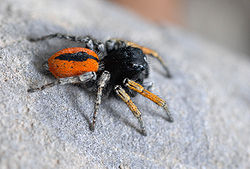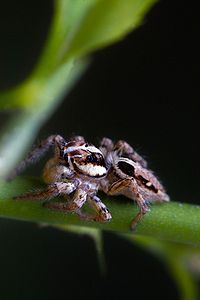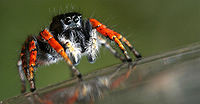- Philaeus chrysops
-
Philaeus chrysops 
Male Scientific classification Kingdom: Animalia Subkingdom: Eumetazoa Phylum: Arthropoda Subphylum: Chelicerata Class: Arachnida Order: Araneae Infraorder: Araneomorphae Section: Dionycha Superfamily: Salticoidea Family: Salticidae Subfamily: Plexippinae Genus: Philaeus Species: P. chrysops Binomial name Philaeus chrysops
(Poda, 1761)Synonyms Aranea chrysops
Aranea sloanii
Aranea catesbaei
Aranea sanguinolenta
Attus sanguinolentus
Salticus sloanii
Salticus catesbaei
Attus bilineatus
Attus sloani
Salticus sanguinolentus
Callietherea sanguinolenta
Philia haemorrhoica
Philia sanguinolenta
Dendryphantes dorsatus
Dendryphantes xanthomelas
Dendryphantes leucomelas
Salticus erythrogaster
Salticus cirtanus
Attus xanthomelas
Philia setigera
Pandora cirtana
Philia erythrogaster
Philia bilineata
Attus haemorrhoicus
Attus nervosus
Dendryphantes bilineatus
Dendryphantes nigriceps
Attus bimaculatus
Philaeus bilineatus
Philaeus nervosus
Philaeus sanguinolentusPhilaeus chrysops is a species of jumping spider (Salticidae).
Contents
Description
Normal body length is 7 to 12 mm, but 5 mm small males do occur. Unusual for spiders, the males are often bigger. The sexes differ extremely: males are very colorful with a glaringly red opisthosoma (chrysops means "golden eye" in Greek). The males have a dark brown cephalothorax with two broad longitudinal white stripes behind the rear eyes. The abdomen is bright orange-red on the back and the sides, with a longitudinal black stripe in the center and black shoulders. The long, slender legs are dark with the patellae and most of the tibiae of the first two pairs bright orange-red. The cephalothorax of the female is similar to the male, but with much smaller white stripes. The back of her abdomen is largely covered with a very broad brown band with two narrow longitudinal white stripes and a few white marks near the sides. The remainder of the abdomen and the sides are orange, the legs light brown with dark brown rings.[1]
The spider prefers open and warm areas.
Distribution
P. chrysops occurs in the Palearctic, reaching into South China[1]
Footnotes
References
- Murphy, Frances & Murphy, John (2000): An Introduction to the Spiders of South East Asia. Malaysian Nature Society, Kuala Lumpur.
- Platnick, Norman I. (2007): The world spider catalog, version 8.0. American Museum of Natural History.
External links
Images
- digilander.libero.it: male with fly - male front view - male - male top view

This article about jumping spiders is a stub. You can help Wikipedia by expanding it.


